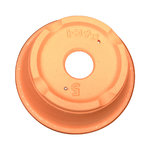You are using an out of date browser. It may not display this or other websites correctly.
You should upgrade or use an alternative browser.
You should upgrade or use an alternative browser.
How to anchor in pot with only 2 wire holes (Tokoname training pots)
- Thread starter Ply
- Start date
Wires_Guy_wires
Imperial Masterpiece
I've used chop sticks wired together as an extra anchor in the top soil. Make a square or triangle to have a perfect distribution of tension.
But I've also used two loops of wire through those holes instead of just one; one on each side of the trunk.
But I've also used two loops of wire through those holes instead of just one; one on each side of the trunk.
roberthu
Chumono
I use galvanized steel wire for tie down. See if you can get 2 wires through each hole. If you can, then you should be good to go. Otherwise, see if you can anchor chopsticks to the pot. Ryan has talked about the technique extensively in his videos and I have used it for tie down in small pots several times. You just have to be precise when cutting the chopsticks to length so they are snug in the pot.
Hack Yeah!
Omono
You could drill extra holes
TrevorLarsen
Shohin
Put one wire through the 2 holes then put 2 or 3 wires under it inside the pot then tie down the one wire as tight as you can, it should hold the 2-3 inside the pot.
Ply
Mame
Do you mean jamming a chopstick into the rootball, and tying a wire to that? I've seen Ryan do that. Unfortunately only works with very dense rootballs, and the trees I intend for these pots are still very much in development.I use galvanized steel wire for tie down. See if you can get 2 wires through each hole. If you can, then you should be good to go. Otherwise, see if you can anchor chopsticks to the pot. Ryan has talked about the technique extensively in his videos and I have used it for tie down in small pots several times. You just have to be precise when cutting the chopsticks to length so they are snug in the pot.
Ply
Mame
I think for the larger pots I could fit in two wires in a single hole, for the smaller sizes, not so much.I've used chop sticks wired together as an extra anchor in the top soil. Make a square or triangle to have a perfect distribution of tension.
But I've also used two loops of wire through those holes instead of just one; one on each side of the trunk.
Do you happen to have a picture of the chopstick situation? I've been thinking about experimenting with that, as even with 4 wire holes, I find wiring sapplings, or trees with little roots a huge pain to wire securely into a pot.
Wires_Guy_wires
Imperial Masterpiece
I don't have a picture of it unfortunately. But in essence it's just a triangle of chopsticks that I anchor through the holes.
You could also make a loop from wire, drape it over the nebari, and tie that down to the pot holes. Should be strong enough to resist the wind, just not strong enough to lift the pot by grabbing the plant.
You could also make a loop from wire, drape it over the nebari, and tie that down to the pot holes. Should be strong enough to resist the wind, just not strong enough to lift the pot by grabbing the plant.
coltranem
Chumono
Trees with immature root balls are always a challenge to tie down. With these grow pots I usually try to use two wires leaving 4 ends to tie down. I have cut bamboo skewers to aid in that process but sometimes I have had to resort to guying the tree to keep it steady. It is in a grow pot it doesn't need to look pretty just be effective.
roberthu
Chumono
No. I mean jam the chopstick on the wall of the pot and press down on the roots. The fraction between the chopstick and the interior wall of the pot is going to hold the roots down. You should be able to grab the chopstick and lift the pot up.Do you mean jamming a chopstick into the rootball, and tying a wire to that? I've seen Ryan do that. Unfortunately only works with very dense rootballs, and the trees I intend for these pots are still very much in development.
Deep Sea Diver
Masterpiece
(Just in case you decide to drill…)
We have at least 80+ trees in tokoname training pots... and about 20 other empty pots on the side at the moment.
We used to wire using the two drain holes. That involved twisting two smaller wires together in the middle, running the two ends up each hole, then separating the wires once out of holes and tied down the tree using a half basket arrangement.
The down side was we wanted more drainage on the sides for the rainy season where we routinely chock up separate pots or entire benches of pots to improve drainage and this method merely clogged up the side holes. Also the holes weren’t spaced out around the clock… and then we got a batch of pots with tiny poorly placed wire holes.
So the decision was made to drill all the pots. Originally I thought it might be a big deal, but this turned out to be much simpler than drilling out high fired pots. One just needs a 3/16 or 1/4” diamond bit - those used for drilling tile at the local hardware. Also a tub of water and a drill.
It’s pretty simple from there. Here’s some photos to help.
Put pot in tub of water upside down, with bottom of pot just below the surface. (It helps to prevent blowout if one puts wood chocks on the inside of the pot. We no longer use these for Tokoname pots as the clay is relatively soft.)
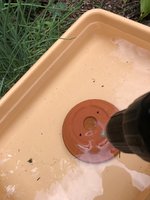
Start drilling at a 45 degree angle at high speed. Once the drill begins to bite in, shift to 90 degrees and drill down with medium pressure. Drill the ‘four corners’. Here the result.
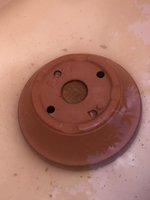
Tie down is easy. Be sure to twist the wires. This keeps the tie downs from sliding around…. and it doesn’t matter which ends of the wire one ties together!
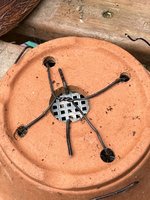
Here’s a half basket tie down arrangement. Used for smaller trees, esp. with fine roots like azalea.
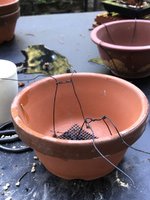
FWIW
Cheers
DSD sends
We have at least 80+ trees in tokoname training pots... and about 20 other empty pots on the side at the moment.
We used to wire using the two drain holes. That involved twisting two smaller wires together in the middle, running the two ends up each hole, then separating the wires once out of holes and tied down the tree using a half basket arrangement.
The down side was we wanted more drainage on the sides for the rainy season where we routinely chock up separate pots or entire benches of pots to improve drainage and this method merely clogged up the side holes. Also the holes weren’t spaced out around the clock… and then we got a batch of pots with tiny poorly placed wire holes.
So the decision was made to drill all the pots. Originally I thought it might be a big deal, but this turned out to be much simpler than drilling out high fired pots. One just needs a 3/16 or 1/4” diamond bit - those used for drilling tile at the local hardware. Also a tub of water and a drill.
It’s pretty simple from there. Here’s some photos to help.
Put pot in tub of water upside down, with bottom of pot just below the surface. (It helps to prevent blowout if one puts wood chocks on the inside of the pot. We no longer use these for Tokoname pots as the clay is relatively soft.)

Start drilling at a 45 degree angle at high speed. Once the drill begins to bite in, shift to 90 degrees and drill down with medium pressure. Drill the ‘four corners’. Here the result.

Tie down is easy. Be sure to twist the wires. This keeps the tie downs from sliding around…. and it doesn’t matter which ends of the wire one ties together!

Here’s a half basket tie down arrangement. Used for smaller trees, esp. with fine roots like azalea.

FWIW
Cheers
DSD sends
Time Wizard
Sapling
I'm surprised nobody in this thread has said the "common way" to use these pots is to just stick one wire through the two holes and use the one wire to tie the tree in. Using one wire has never caused me any problems; it will hold the tree in place well enough until the roots get established.
Deep Sea Diver
Masterpiece
Common way? Haven’t seen this as a routine method. Please tell us more.
Cheers
DSD sends
Cheers
DSD sends
Time Wizard
Sapling
I don't necessarily mean to imply that's the standard way to wire a tree into a pot, I was using the OP's wording. Although I was more or less under the assumption that was somewhat standard or common. I've never thought it necessary to drill extra holes into a pot or use some of the other methods others have described. If I have space for one wire I just use one wire. I'm by no means a professional, though.Common way? Haven’t seen this as a routine method. Please tell us more.
Cheers
DSD sends
BobbyLane
Imperial Masterpiece
You're right that is the way a lot of experienced hobbyists do it. That method has been around a long time. Pretty sure @leatherback did a video on it a while ago. But you can find this information all over the Web.I'm surprised nobody in this thread has said the "common way" to use these pots is to just stick one wire through the two holes and use the one wire to tie the tree in. Using one wire has never caused me any problems; it will hold the tree in place well enough until the roots get established.

How to secure bonsai in the pot - Bonsai Tonight
Step-by-step instructions for securing bonsai into pots with one, two, three or four drainage holes. This is article 7 of a 10 part series for beginners.
 bonsaitonight.com
bonsaitonight.com
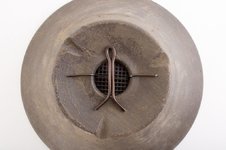
Last edited:
Deep Sea Diver
Masterpiece
Very familiar with this method @BobbyLane. It does use two wires vs one, that was my hang up. Looking to see if I somehow missed a one wire technique. 
Normally used for shohin out here. Believe Morton Albek was showing this method in an on line course too. Lots of older skinny cascade pots have one hole and use that two wire one hole method.
I have been blessed to work with a number of professionals including our Curator at the museum. I can say the one hole method has been rarely if ever used.
Not to worry. This is a good discussion point. It’s done quite a bit out here.
The torrential rains in the PacNW have caused this procedure to be pretty popular out here.
During the rains we used to merely chock up one side of the pot to lower the water table inside. The last ten years rains have shown a need for even more drainage. Hence the drilling if a pot doesn’t have four corners holes. Most of the newer pots by the artists out here all come with side drainage.
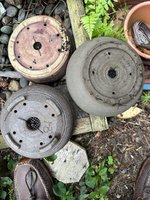
Cheers
DSD sends
Normally used for shohin out here. Believe Morton Albek was showing this method in an on line course too. Lots of older skinny cascade pots have one hole and use that two wire one hole method.
I have been blessed to work with a number of professionals including our Curator at the museum. I can say the one hole method has been rarely if ever used.
I've never thought it necessary to drill extra holes into a pot or use some of the other methods others have described.
Not to worry. This is a good discussion point. It’s done quite a bit out here.
The torrential rains in the PacNW have caused this procedure to be pretty popular out here.
During the rains we used to merely chock up one side of the pot to lower the water table inside. The last ten years rains have shown a need for even more drainage. Hence the drilling if a pot doesn’t have four corners holes. Most of the newer pots by the artists out here all come with side drainage.

Cheers
DSD sends
bwaynef
Masterpiece
I do as Jonas teaches w/ the cotter pin. Boon calls it "little man". I don't have any problems with the recommendation that those tokoname training pots need more drainage holes though.
Ply
Mame
Same, aware of the method described above, but still curious about whether a one wire technique actually exists and what that would look like.Very familiar with this method @BobbyLane. It does use two wires vs one, that was my hang up. Looking to see if I somehow missed a one wire technique.
Thanks for the write up.(Just in case you decide to drill…)
We have at least 80+ trees in tokoname training pots... and about 20 other empty pots on the side at the moment.
We used to wire using the two drain holes. That involved twisting two smaller wires together in the middle, running the two ends up each hole, then separating the wires once out of holes and tied down the tree using a half basket arrangement.
The down side was we wanted more drainage on the sides for the rainy season where we routinely chock up separate pots or entire benches of pots to improve drainage and this method merely clogged up the side holes. Also the holes weren’t spaced out around the clock… and then we got a batch of pots with tiny poorly placed wire holes.
So the decision was made to drill all the pots. Originally I thought it might be a big deal, but this turned out to be much simpler than drilling out high fired pots. One just needs a 3/16 or 1/4” diamond bit - those used for drilling tile at the local hardware. Also a tub of water and a drill.
It’s pretty simple from there. Here’s some photos to help.
Put pot in tub of water upside down, with bottom of pot just below the surface. (It helps to prevent blowout if one puts wood chocks on the inside of the pot. We no longer use these for Tokoname pots as the clay is relatively soft.)
View attachment 506500
Start drilling at a 45 degree angle at high speed. Once the drill begins to bite in, shift to 90 degrees and drill down with medium pressure. Drill the ‘four corners’. Here the result.
View attachment 506501
Tie down is easy. Be sure to twist the wires. This keeps the tie downs from sliding around…. and it doesn’t matter which ends of the wire one ties together!
View attachment 506502
Here’s a half basket tie down arrangement. Used for smaller trees, esp. with fine roots like azalea.
View attachment 506499
FWIW
Cheers
DSD sends
It does strike me as oddthat they would create training pots specifically for bonsai, yet would not make it convenient to anchor trees by only creating two holes rather then four. Seems like a small extra step in the process of making these.
Oh well, drilling works. I used to drill holes in regular terracotta containers, it's quite a quick process really. But still didn't expect it to be neccesary on these pots. Although I might give one of the other methods a try as well, just to experiment a bit.
Deep Sea Diver
Masterpiece
Certainly! Your trees your choice.
If there aren’t a series of continuous rains in various seasons, perhaps go with the cotter key method. It’s elegant!
cheers
DSD sends
If there aren’t a series of continuous rains in various seasons, perhaps go with the cotter key method. It’s elegant!
cheers
DSD sends
leatherback
The Treedeemer
Yeah, this I do use at timesYou're right that is the way a lot of experienced hobbyists do it. That method has been around a long time. Pretty sure @leatherback did a video on it a while ago. But you can find this information all over the Web.

How to secure bonsai in the pot - Bonsai Tonight
Step-by-step instructions for securing bonsai into pots with one, two, three or four drainage holes. This is article 7 of a 10 part series for beginners.bonsaitonight.com
View attachment 506534
Similar threads
- Replies
- 9
- Views
- 1K
- Replies
- 17
- Views
- 1K
- Replies
- 33
- Views
- 5K
- Replies
- 25
- Views
- 2K
- Replies
- 23
- Views
- 522

